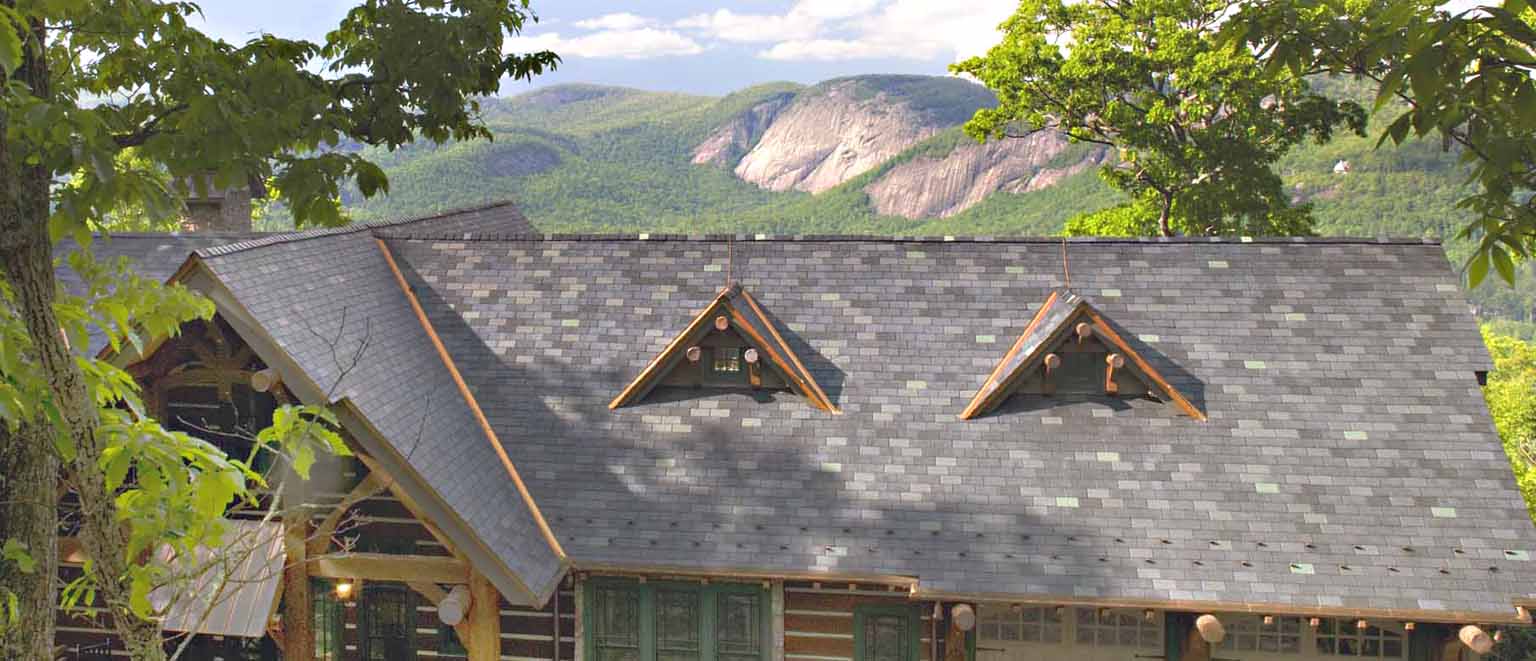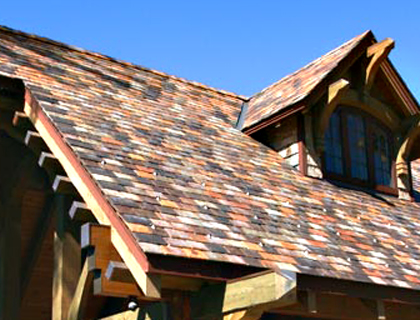There is a great VALUE in having a licensed Architect design your house. Specifically, this is the first in a series of online articles, looking at hard numbers and how those indicate that having a knowledgeable residential Architect design your house will SAVE you many times the cost of their services over the life of your residence.
Each of these articles will focus on a specific topic: Roofing, Windows & Doors, Energy Conservation & Your Utility Bills, Health & Your House, and more. This first article focuses on Roofing. What is remarkable about each of these studies is that ANY ONE OF THEM can provide financial evidence that having a real Architect design your house can save you more than what you pay them for their Basic Services. And, when this series is done being written, we will combine them into a final chapter, offering a stunning array of facts and costs illustrating that perhaps the entire cost of the whole house, over time, can be saved, if you have an experienced residential Architect design your residence. For more general information about Value Engineering of Houses, you may wish to click here –> Value Engineering.

An Architect Designing your House = Value
Okay, let’s get started with ROOFING. Most people expect their roofs to fail, especially if they have owned a house for 10 years or more. Even though most asphaltic roof shingle manufacturer’s call their shingles: 20 year, 25 year, 30 year and 40 year shingles, the reality is that the shingles themselves or, even more likely, the cheap underlayment below them starts leaking long before the stated shingle lifetime. Architects highly experienced with the design of houses know about alternate roof sheathing membranes that, for a just a little more money, last a LOT longer that what your normal roofer or handyman will use to reroof your house. Cheapest is NOT the best, in this particular case. By having an Architect who is experienced in these matters (Home Architects ®) design your residence, you can save tens of thousands of dollars over the life of your house.
For more information about shingle roofs, you may want to click here –> roof flashing, or here –> how your Architect keeps your roof looking new, or here–> Photovoltaic roof shingles.
The ugly truth is: water can and does get through your roof shingles. Then, the quality of the underlayment membrane comes into play. If you have a cheap one (typically a single or double layer of 15# asphaltic felt, which works great as a wall underlayment, but not as well on roofs), water will move around, rotting wood, growing mold, leaking through the sheathing, into your attic and eventually down into the living areas of your house. Experiencing a roof leak is an unpleasant experience. We feel helpless and know that we are about to have to pay thousands of dollars to fix it. UNLESS you have avoided leaks entirely, by having a quality residential Architect specify a “WURM”. This stands for Waterproofing Underlayment Roofing Membrane. Not too many roofers or General Contractors, for that matter are familiar with their usage for whole-roof installations. They see them as unnecessary overkill. And because they look forward to receiving your phone calls to pay them to replace the roofing about every 10 years. So: listen to the builder who wants you to continue to pay him or her for the life of your house, or listen to your Architect whom you can pay once and have the problem solved for far longer.

How long? Likely as long as the life of the roof shingles and sometimes, even a little longer. So if you truly have a 30 year roof shingle, which is a fairly common “architectural” grade shingle, your underlayment may last that long and longer. However, for the purposes of the numbers in this study, we are showing the underlayment being replaced when the shingles are replaced, because roofers typically use shovels to scrape off the roof shingles and we don’t know many underlayments of any kind that will survive that rough treatment. Even so, this means that the Architect-specified roof system lasts perhaps 30 years and the non-Architect roof system lasts perhaps an average of 10 years before needing replacement. We have seen asphaltic fiberglass roof shingle roofs last 7 years to perhaps 15 years on average, so we thought that a decade provided a reasonable mid-point. Some last longer, other shorter, depending on the circumstances and quality of installation and peripheral elements.
What peripheral elements? Metal flashings around the edge of the roof (and possibly more in the body of the roof), ridge venting, and other devices, like exhaust fan housings. For the purposes of this study, we have included costs for these items: Roof shingles, underlayment, deck repairs (caused by the cheaper roof leaking), flashing replacement (which shouldn’t always need to be redone, but likely will, due to the aforementioned shovel method of shingle removal), roof vent ridge replacement, reroof labor, tear0ff labor, disposal of removed material. Costs could be even higher for your situation, if you have a chimney, which will need to be reflashed, exhaust fan housings and other apparatus. Some roofers may quote less or more, depending on what they imagine they can reuse. We have assumed that the flashing and ridge vents will need to be purchased new and reinstalled with each reroofing.
Click here for more information on –> Roof Shingles on Houses.
So how much does it cost to reroof for the common, non-Architect method? Well, this depends on many factors. Let’s say that you have a 3,000 HSF (Heated Square Feet) house distributed over two stories. And let’s say that you have a GSF (Gross Square Foot) of roofing of 2,600 GSF. Based on the spreadsheet analysis you see below, it appears that a common reroof every 10 years might cost you around $11,730 (not adjusted for inflation and highly variable depending on your location, complexity of roof, added flashing, quality of shingle, ease of access for the roofers and other issues). Now then, if your house is expected to be around for 100 years, which is fairly common, then you may need 10 reroofings. NOT adjusted for inflation, using today’s value of dollars, this would total $117,300. over the life of the house.
You may want to click here for more information on –> residential roofing design and material analysis.
How does this compare with the slightly higher quality system specified by the Architect? The cost to reroof might be around $13,290. This is slightly higher, accounting for the superior WURM being used and a few other minor, but important things (like your Architect specifying special, but inexpensive nails that cannot back out). And, here’s the most important part: the roof should last up to 3x LONGER (possibly longer, depending on the quality of the shingle)! So if this better roof system is replaced perhaps every 30 years (what your shingle manufacturer says your shingle should be worth (for a “30 year shingle”), if other related components, like the underlayment and flashings can also last that long), then you would only replace that better roof system 3 times during the house’s lifetime. $13,290 x 3 = $39,870.
In other words, you save: $117,300 (cost of replacing the non-Architect roof system) – $39,870 (cost of replacing the Architect roof system) = $77,430 SAVINGS having your Architect design and specify your house, just considering the roof replacement cost alone!
But wait! What about the cost of the Architect? Okay. Let’s consider that. First of all, you are going to have a better quality of life in a better-designed house and it will likely sell for more when and if you decide to sell it someday, due to the increased curb appeal, and enhanced interior functionality and the other benefits of living in a house designed just for you. However, let’s just consider the situation with the roofing benefits. If the constructions costs for a mid-range to lower-middle house are in the $150/HSF range in your area and if that is what you have your Architect create, then your 3,000 HSF house x $150/SF will = $450,000 to originally construct. It can be done for less, or more, depending on your desires for the project (this firm has created homes as low as $100/HSF to over $200/HSF and more, depending on client desires). So, if the Architect ends up charging between 4% to 8% of this cost of construction (his fees may be hourly and end up in this range for Basic Services), let’s assume the middle or 6% range x $450k = $27k +/-. Okay, so now let’s see: $77,430 savings – $27k Architect fee = $50,430.00 savings. And that’s just for the reroofing savings, not including all the other savings that our other articles are going to explain. Exactly HOW does your Architect make this savings happen for you? By your continued use of his specifications, every time your house needs to be reroofed.
And here is the FINANCIAL ANALYSIS documenting the above conclusions:
If you are interested in having a residential Architect help save you money over the life of you house, you may wish to consider contacting: Rand@HomeArchitects.com 828-269-9046
Click here for this Architectural website: www.HomeArchitects.com
tags: value of an Architect, Atlanta, Cashiers, custom, newnan, aspen, telluride, chicago, hendersonville, asheville, post and beam, timber, value engineering

